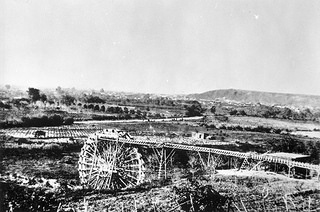Waterwheel and the Zanja Madre
In 1857 William Dryden and his newly incorporated water company, Los Angeles Water Works Co., erected a forty foot water wheel to lift water from the Los Angeles River to the city’s main water ditch, the Zanja Madre. An image of this water wheel can be seen on the left, which was captured in 1863. Dryden constructed a large brick and wood storage tank in 1858 in La Placita, the city’s plaza which was located about one mile north of Azusa Street. It would remain there for about 10 years and then be replaced by a fountain. Afterward, water would continue to be stored in other tanks on the periphery of the plaza as well as in other nearby reservoirs.
The conversion from total dependence on the zanja system for domestic water to an underground iron pipe water system began in 1867. Jean Louis Sansevain, a Frenchman who owned an extensive vineyard and winery on Aliso Street, was authorized by the City Council to lay 5,000 feet of iron pipe and to build a dam and reservoir. Discouraged by repeated failures, Sansevain the following year offered his lease to a group of individuals who formed a private corporation known as the Los Angeles Water Company.


